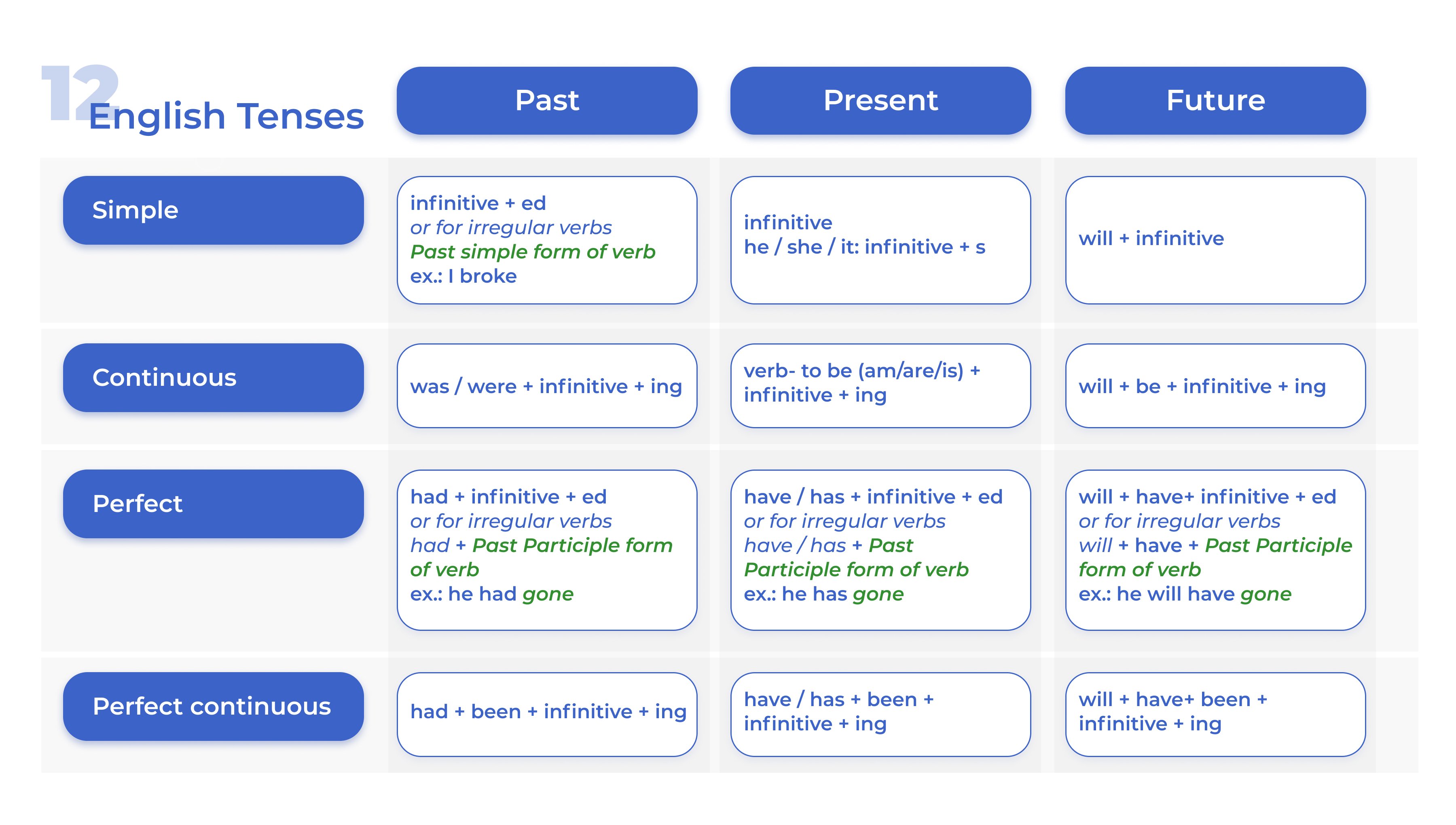How to Learn English Grammar: Practical Steps and Tips
Are you interested in the question How to learn English grammar? In this article you will find simple steps and tips for learning English grammar. Click and explore!
Feb. 7, 2023

Are you interested in the question What are verb tenses? There are three basic forms of tenses, but there are a total of 12 basic verb tenses in the English language.
What are the tenses of verbs? How many tenses there are in English? What are the types of verbs used in English?
Firstly, let’s talk about the types of verbs. What is a verb? A verb is a word that shows action in a sentence / describes what the subject is doing or expresses a state of being. There are several different types of verbs in the English language, each with its own unique characteristics and uses: regular and irregular verbs, transitive and intransitive verbs, stative and dynamic verbs, linking verbs, modal verbs, auxiliary (helping) verbs, phrasal verbs.
Regular and irregular verbs
About regular verbs everything is clear. It’s a majority part of verbs and it’s follow the same pattern. In the past verb tense the usual rule is adding “-e” or “-ed” to the infinitive form of verbs. For example: dance – danced, cry – cried, open – opened, fix – fixed.
Let’s deal with irregular verbs. Irregular verbs don’t have a general rule of formation, but there are two different verb forms: past simple and past participle. For example, "see" becomes "saw" in the past tense and “seen” in the past participle: "go" becomes "went" in the past tense and becomes “gone” in the past participle. These verbs are often more difficult to learn because they do not follow a set pattern.
We won’t specify them all, because English list of verbs consists of 100 words. You can find this list really easy and you just need to remember them all.
Transitive and intransitive verbs
Transitive verb is used with a direct object, such as noun, pronoun or noun phrase. Whereas intransitive verb is used with prepositional phrases, adjectives and adverbs.
Stative and dynamic verbs
Dynamic verbs or action verbs: run, eat, speak, think, help or ignore etc. This type of verbs is used to refer to some actions.
Examples of sentences with a dynamic verb:
Stative verbs are: be, have, own, love, like, want and describes a condition or a state of being. We use them to describe emotions, qualities, opinions. Stative verbs are not usually used in continuous forms.
Examples of sentences with a stative verb:
It's worth noting that some verbs can be both stative and dynamic depending on the context in which they are used, such as "have" which can be stative verb in "I have a book" and dynamic in "I have a meeting" and "see" can be stative verb in "I see the problem" and dynamic verb in "I am seeing the doctor"
Linking verbs
Linking verbs are used to indicate a state or condition of being, rather than an action. Verb "to be", "become", "appear", "grow", "get" – these are examples of linking verbs that are used to link a subject with a subject complement. In the sentence "She is happy," the linking verb "is" connecting the subject "she" to the adjective "happy”.
Let’s see and the other examples:
It is important to note that linking verbs do not have a direct object and can't be modified by adverbs.
Modal verbs
Modal verbs are used to express a necessity, possibility, permission or ability to do something. Examples of modal verbs: can, may, must, will, would, should, shall and might.
Here are the examples in a sentence.
Auxiliary (helping) verbs
Auxiliary verbs are helpful and include verbs such as be, do, have, will, would etc. They are used to form questions, negations, and to indicate emphasis. You have to use them with a main verb in a sentence and if you want to change its meaning.
Auxiliary or helping verbs in sentences:
Phrasal verbs
Phrasal verbs are groups of words that are used like a verb and consist of a verb with an adverb or preposition after it: look after; put off, bring up. These verbs can be difficult to understand because the meaning of the verb phrase is often different from the meanings of the individual words.
Example of phrases and sentences:
Finally, the '–ing forms', they are gerunds and present participles built by adding “-ing” at the end of words. Dance – dancing, sing- singing, run – running etc.
Example of sentences:
Summary about the types of verbs. Verbs are an essential part of the English language, and there are many different types of verbs each with its unique characteristics. Understanding the different types of verbs and how they are used can help improve your writing and speaking skills. Having understood the verbs, you will solve the biggest issue about English grammar.
What are the tenses of verbs and how to use them? How many verb tenses there are in English?
There are three main groups of tenses in English: past tenses, present tenses and future tenses. Every group of verb tenses has their own four aspects: Simple, Continuous, Perfect and Perfect Continuous.
Past tenses
Present tenses
Future tenses
Below is the formula for each of the twelve tenses in English. Save this picture as a cheat sheet.

Learning the different types of verbs can be relatively easy, as they often follow regular patterns and can be categorized based on their function in a sentence. Additionally, many verbs can be identified by their form, such as the -ing or -ed ending, which can be helpful in identifying the type of verb it is.
So, what is a verb tense? Let`s repeat. The tense of the verb indicates the sequence of actions: whether the action has already taken place (past), if the action is taking place now (present). verb indicates action in the future (future), the action is in a progress (continuous), or you want to indicate that the action is not already complete (perfect).
The importance of learning verb tenses is that it helps to improve one's communication. It allows one to express oneself more clearly and accurately, which is essential for effective communication in any language. Additionally, understanding verb tenses enables one to understand the time context of what one is reading or hearing. This is crucial for comprehension and making meaning of any text or speech.
Verb tenses are used to indicate the time at which an action takes place. Understanding verb tenses is important for effective communication and comprehension in any language.